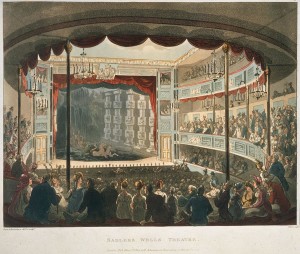Community, Leadership, Experimentation, Diversity, & Education
Pittsburgh Arts, Regional Theatre, New Work, Producing, Copyright, Labor Unions,
New Products, Coping Skills, J-O-Bs...
Theatre industry news, University & School of Drama Announcements, plus occasional course support for
Carnegie Mellon School of Drama Faculty, Staff, Students, and Alumni.
CMU School of Drama
Monday, January 14, 2019
The Case for Boxes
theatreconsultants.org: Box seating has been a part of the architectural vocabulary of auditorium design since the art forms of theatre, music, opera and dance began to gain prominence in the late 1500s. Boxes evolved in Europe from the use of found spaces that included salons, tennis courts, bear-baiting arenas and interior courtyards, and in Asian countries with the use of teahouses and festival platforms for performance.
Subscribe to:
Post Comments (Atom)

4 comments:
I have never really thought much about box seats in theatres until I read this article. They have always just been something that I find in some theatres and when I don’t see them I have never really thought much of it. So reading this article I found very interesting. I think that the idea of box seats being used as seats which are accessible for wheelchairs is a great idea. I think that the idea that they are used for people who pay more money to get seats where they can be seen by everyone and where they feel fancier is definitely an idea set in the past because that was such a common occurrence, but I think that these days paying extra money for a seat where you cannot see as well is kind of foolish and if one is really only doing that so people know that they paid more money then why are they really seeing a show in the first place? But I also don’t really care that much and if box seats are something that a theater wants to have then great and people who want to pay to sit in them can. And if a theater doesn’t want to have box seats then also great and no one will sit in them.
While I never necessarily attributed my dislike of some theaters to the absence of side boxes, I now see the correlation. Every theater that I have liked the set up of or thought was pretty had side boxes. This may be a side effect of box seating costing extra and therefore being a symptom of a company with the money to build an aesthetically pleasing theater, but I do think the existence of box seating connects balcony seating with the rest of the space to make it much more cohesive. I don't think they are necessary though, and in most cases are not super practical. It is great that they can be used to house guests in wheel chairs, but I don't think they usually are, and as noted in the article it is significantly more difficult to see the stage properly without leaning over the banister which defeats the purpose if they were to be used for people in wheelchairs.
Tradition must never be discounted as antiquated and in desperate need of updating, and boxes certainly do not deserve some social movement calling them whatever hot topic word comes immediately to mind. I have never sat in an official box, mostly because I can not afford them, but my parents taught me very early on not to envy something someone else has and therefore I do not care, necessarily. Would I like to at one point? Of course I would, but I prefer to sit on just either side of center half to three quarters up in the orchestra level. To me the draw of the boxes is not the view it is about the being the view, and I love that. Nothing makes me more depressed than a plain brick theatre, being from Chicago half of the magic of the theatre was the glitter of the buildings themselves. Nothing is more majestic then the elephants of the Oriental or the crystals and gold of the Cadillac Palace, I wish more theatres were built with the glitter, because as much as we might try to fight it, being go to the theatre for the glitter and the magic not to squirm in their seats out of being uncomfortable.
Box seating is traditionally reserved for those elite members of society and the audience. However, they traditionally had very poor views of the actual stage. The point of these seats was so that the entire audience could see you. Because of this, I disagree with the existence of box seats. I believe that they are elitist and promote elitist attitudes in theatre. This is something that theatre already struggles with. Box seating, while truthfully not the problem itself, is symptomatic of a larger problem. Theatre has a serious problem in attempting to attract a younger audience. Box seating only helps to continue to worsen this problem and is a prime example of this. This article seems to argue that the existence of box seating is important to the history of theatre, which I am inclined to disagree with, and I do not think that this is a valid reason to continue such a bizarre tradition.
Post a Comment